Charlotte Perkins Gilman's 'The Yellow Wallpaper': A Medical Lens
VerifiedAdded on 2023/01/16
|7
|1665
|40
Essay
AI Summary
This essay delves into Charlotte Perkins Gilman's "The Yellow Wallpaper," examining its medical references and commentary on Victorian-era medical practices and beliefs. The story, presented as diary entries, chronicles the narrator's deteriorating mental health as she is subjected to the rest cure for neurasthenia, a common diagnosis for women at the time. The wallpaper itself becomes a symbol of the narrator's confinement and the oppressive nature of Victorian society's treatment of women's health issues. The essay analyzes how Gilman critiques the era's medical doctrines, particularly regarding hysteria and the suppression of women's creativity and autonomy. It also discusses the historical context of nervous diseases and their association with women, highlighting the story's feminist perspective on medical mistreatment and the struggle for self-expression.
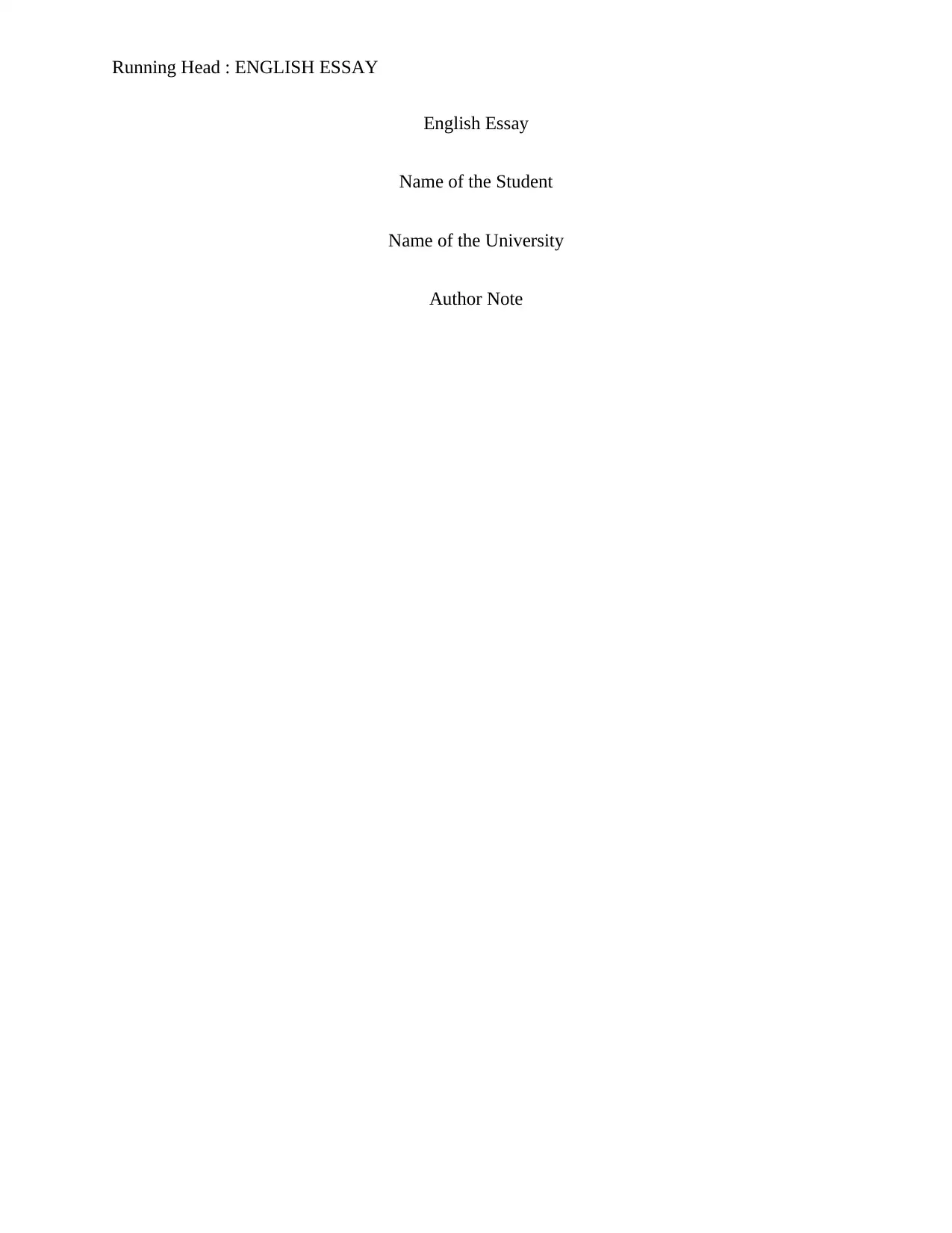
Running Head : ENGLISH ESSAY
English Essay
Name of the Student
Name of the University
Author Note
English Essay
Name of the Student
Name of the University
Author Note
Paraphrase This Document
Need a fresh take? Get an instant paraphrase of this document with our AI Paraphraser
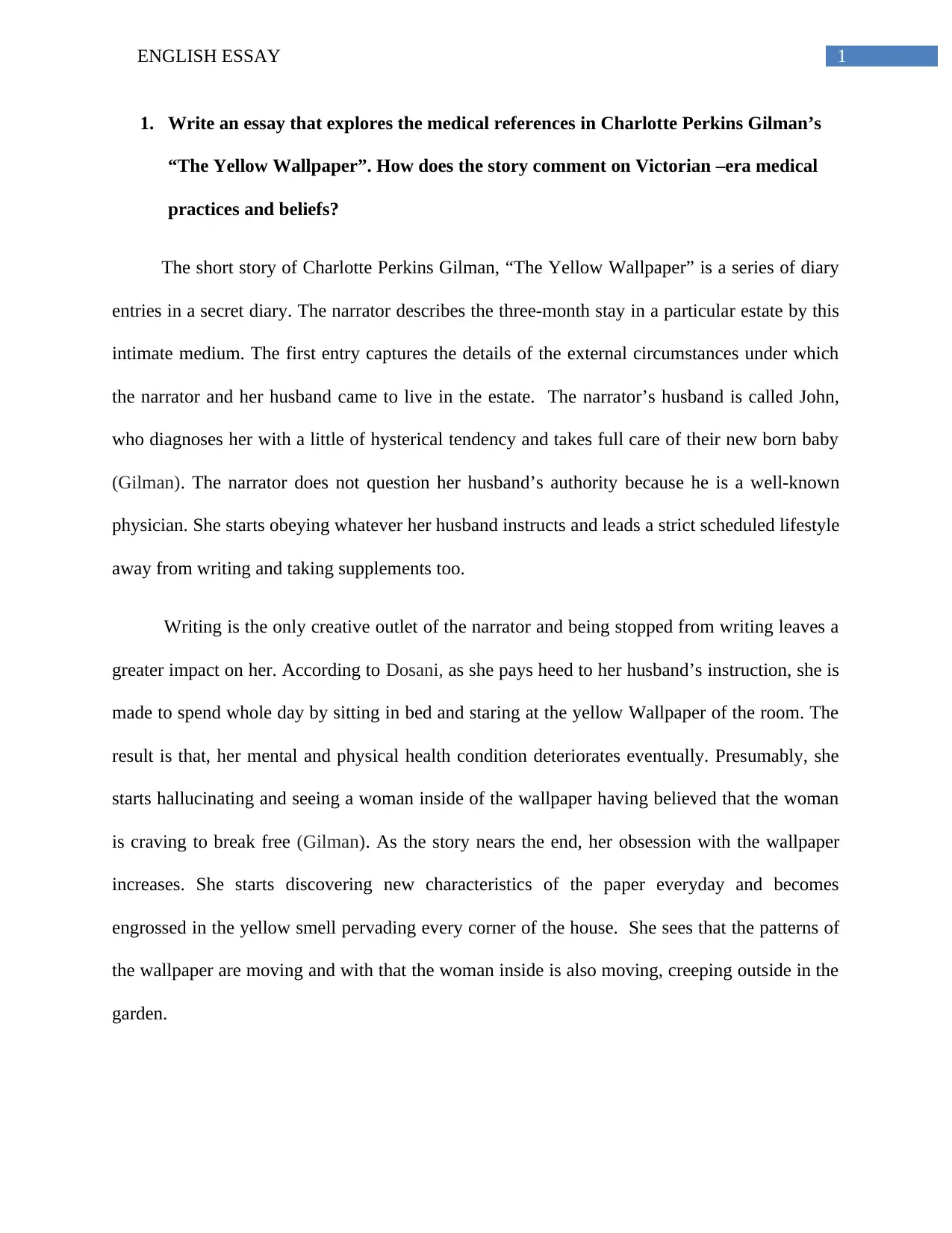
1ENGLISH ESSAY
1. Write an essay that explores the medical references in Charlotte Perkins Gilman’s
“The Yellow Wallpaper”. How does the story comment on Victorian –era medical
practices and beliefs?
The short story of Charlotte Perkins Gilman, “The Yellow Wallpaper” is a series of diary
entries in a secret diary. The narrator describes the three-month stay in a particular estate by this
intimate medium. The first entry captures the details of the external circumstances under which
the narrator and her husband came to live in the estate. The narrator’s husband is called John,
who diagnoses her with a little of hysterical tendency and takes full care of their new born baby
(Gilman). The narrator does not question her husband’s authority because he is a well-known
physician. She starts obeying whatever her husband instructs and leads a strict scheduled lifestyle
away from writing and taking supplements too.
Writing is the only creative outlet of the narrator and being stopped from writing leaves a
greater impact on her. According to Dosani, as she pays heed to her husband’s instruction, she is
made to spend whole day by sitting in bed and staring at the yellow Wallpaper of the room. The
result is that, her mental and physical health condition deteriorates eventually. Presumably, she
starts hallucinating and seeing a woman inside of the wallpaper having believed that the woman
is craving to break free (Gilman). As the story nears the end, her obsession with the wallpaper
increases. She starts discovering new characteristics of the paper everyday and becomes
engrossed in the yellow smell pervading every corner of the house. She sees that the patterns of
the wallpaper are moving and with that the woman inside is also moving, creeping outside in the
garden.
1. Write an essay that explores the medical references in Charlotte Perkins Gilman’s
“The Yellow Wallpaper”. How does the story comment on Victorian –era medical
practices and beliefs?
The short story of Charlotte Perkins Gilman, “The Yellow Wallpaper” is a series of diary
entries in a secret diary. The narrator describes the three-month stay in a particular estate by this
intimate medium. The first entry captures the details of the external circumstances under which
the narrator and her husband came to live in the estate. The narrator’s husband is called John,
who diagnoses her with a little of hysterical tendency and takes full care of their new born baby
(Gilman). The narrator does not question her husband’s authority because he is a well-known
physician. She starts obeying whatever her husband instructs and leads a strict scheduled lifestyle
away from writing and taking supplements too.
Writing is the only creative outlet of the narrator and being stopped from writing leaves a
greater impact on her. According to Dosani, as she pays heed to her husband’s instruction, she is
made to spend whole day by sitting in bed and staring at the yellow Wallpaper of the room. The
result is that, her mental and physical health condition deteriorates eventually. Presumably, she
starts hallucinating and seeing a woman inside of the wallpaper having believed that the woman
is craving to break free (Gilman). As the story nears the end, her obsession with the wallpaper
increases. She starts discovering new characteristics of the paper everyday and becomes
engrossed in the yellow smell pervading every corner of the house. She sees that the patterns of
the wallpaper are moving and with that the woman inside is also moving, creeping outside in the
garden.
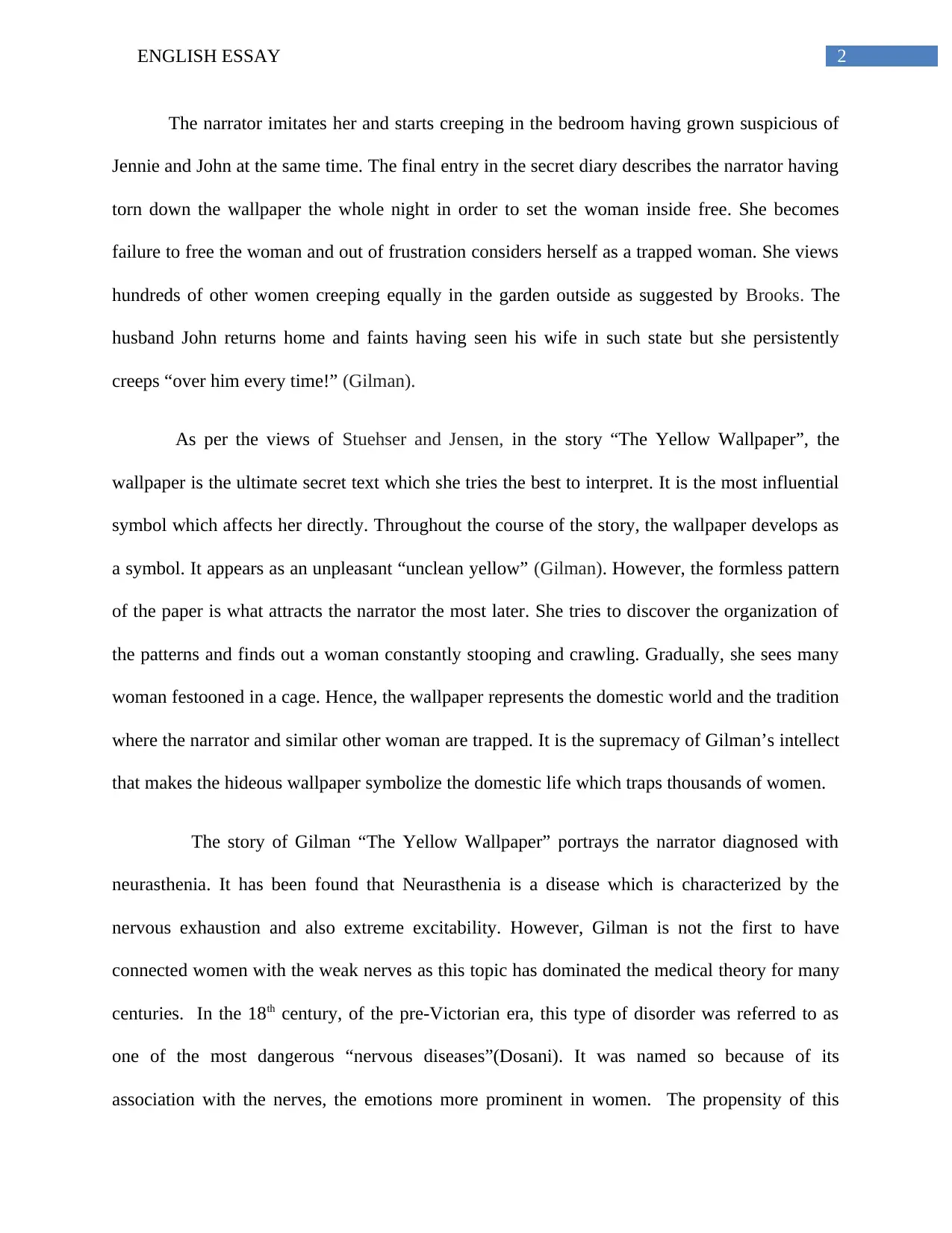
2ENGLISH ESSAY
The narrator imitates her and starts creeping in the bedroom having grown suspicious of
Jennie and John at the same time. The final entry in the secret diary describes the narrator having
torn down the wallpaper the whole night in order to set the woman inside free. She becomes
failure to free the woman and out of frustration considers herself as a trapped woman. She views
hundreds of other women creeping equally in the garden outside as suggested by Brooks. The
husband John returns home and faints having seen his wife in such state but she persistently
creeps “over him every time!” (Gilman).
As per the views of Stuehser and Jensen, in the story “The Yellow Wallpaper”, the
wallpaper is the ultimate secret text which she tries the best to interpret. It is the most influential
symbol which affects her directly. Throughout the course of the story, the wallpaper develops as
a symbol. It appears as an unpleasant “unclean yellow” (Gilman). However, the formless pattern
of the paper is what attracts the narrator the most later. She tries to discover the organization of
the patterns and finds out a woman constantly stooping and crawling. Gradually, she sees many
woman festooned in a cage. Hence, the wallpaper represents the domestic world and the tradition
where the narrator and similar other woman are trapped. It is the supremacy of Gilman’s intellect
that makes the hideous wallpaper symbolize the domestic life which traps thousands of women.
The story of Gilman “The Yellow Wallpaper” portrays the narrator diagnosed with
neurasthenia. It has been found that Neurasthenia is a disease which is characterized by the
nervous exhaustion and also extreme excitability. However, Gilman is not the first to have
connected women with the weak nerves as this topic has dominated the medical theory for many
centuries. In the 18th century, of the pre-Victorian era, this type of disorder was referred to as
one of the most dangerous “nervous diseases”(Dosani). It was named so because of its
association with the nerves, the emotions more prominent in women. The propensity of this
The narrator imitates her and starts creeping in the bedroom having grown suspicious of
Jennie and John at the same time. The final entry in the secret diary describes the narrator having
torn down the wallpaper the whole night in order to set the woman inside free. She becomes
failure to free the woman and out of frustration considers herself as a trapped woman. She views
hundreds of other women creeping equally in the garden outside as suggested by Brooks. The
husband John returns home and faints having seen his wife in such state but she persistently
creeps “over him every time!” (Gilman).
As per the views of Stuehser and Jensen, in the story “The Yellow Wallpaper”, the
wallpaper is the ultimate secret text which she tries the best to interpret. It is the most influential
symbol which affects her directly. Throughout the course of the story, the wallpaper develops as
a symbol. It appears as an unpleasant “unclean yellow” (Gilman). However, the formless pattern
of the paper is what attracts the narrator the most later. She tries to discover the organization of
the patterns and finds out a woman constantly stooping and crawling. Gradually, she sees many
woman festooned in a cage. Hence, the wallpaper represents the domestic world and the tradition
where the narrator and similar other woman are trapped. It is the supremacy of Gilman’s intellect
that makes the hideous wallpaper symbolize the domestic life which traps thousands of women.
The story of Gilman “The Yellow Wallpaper” portrays the narrator diagnosed with
neurasthenia. It has been found that Neurasthenia is a disease which is characterized by the
nervous exhaustion and also extreme excitability. However, Gilman is not the first to have
connected women with the weak nerves as this topic has dominated the medical theory for many
centuries. In the 18th century, of the pre-Victorian era, this type of disorder was referred to as
one of the most dangerous “nervous diseases”(Dosani). It was named so because of its
association with the nerves, the emotions more prominent in women. The propensity of this
⊘ This is a preview!⊘
Do you want full access?
Subscribe today to unlock all pages.

Trusted by 1+ million students worldwide
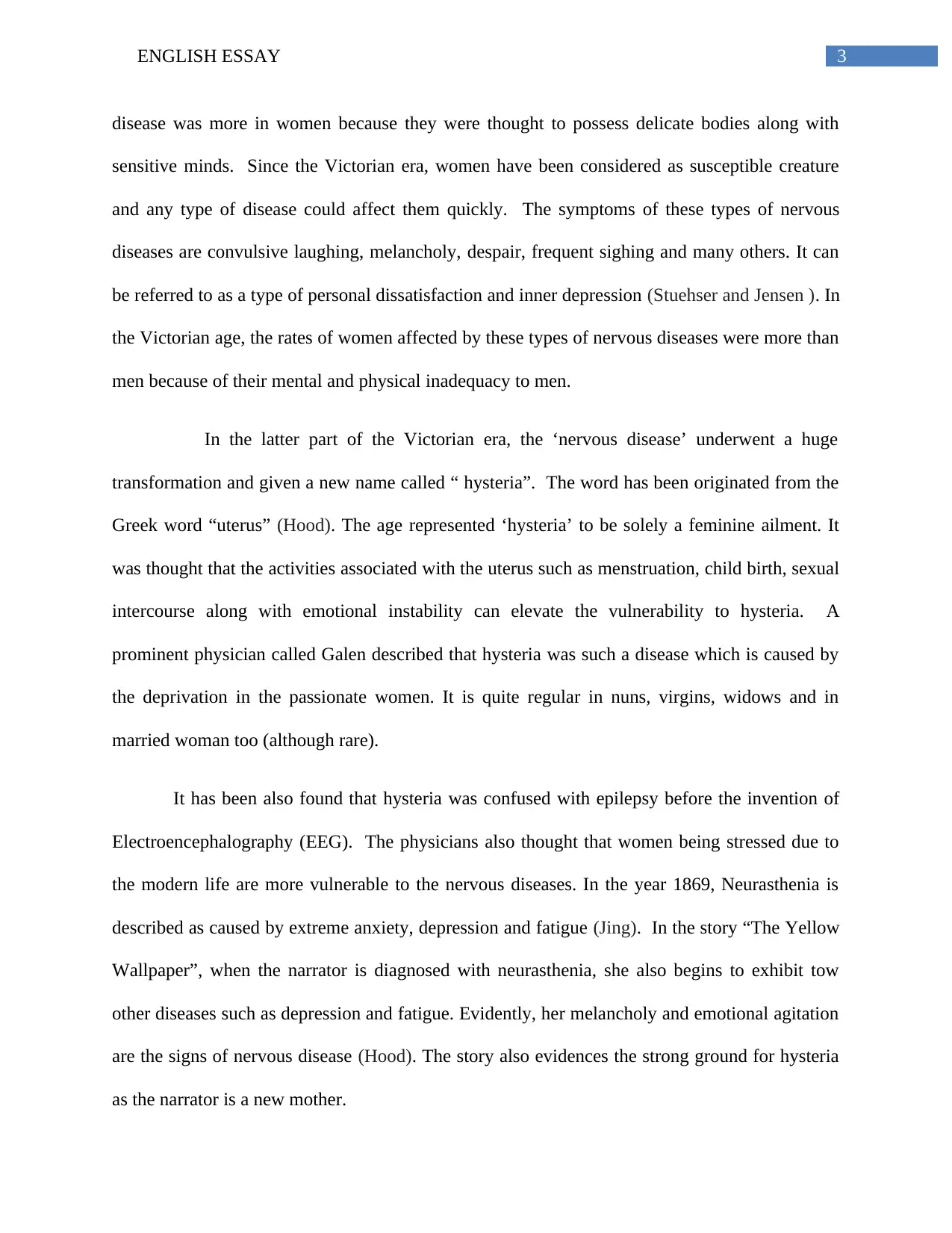
3ENGLISH ESSAY
disease was more in women because they were thought to possess delicate bodies along with
sensitive minds. Since the Victorian era, women have been considered as susceptible creature
and any type of disease could affect them quickly. The symptoms of these types of nervous
diseases are convulsive laughing, melancholy, despair, frequent sighing and many others. It can
be referred to as a type of personal dissatisfaction and inner depression (Stuehser and Jensen ). In
the Victorian age, the rates of women affected by these types of nervous diseases were more than
men because of their mental and physical inadequacy to men.
In the latter part of the Victorian era, the ‘nervous disease’ underwent a huge
transformation and given a new name called “ hysteria”. The word has been originated from the
Greek word “uterus” (Hood). The age represented ‘hysteria’ to be solely a feminine ailment. It
was thought that the activities associated with the uterus such as menstruation, child birth, sexual
intercourse along with emotional instability can elevate the vulnerability to hysteria. A
prominent physician called Galen described that hysteria was such a disease which is caused by
the deprivation in the passionate women. It is quite regular in nuns, virgins, widows and in
married woman too (although rare).
It has been also found that hysteria was confused with epilepsy before the invention of
Electroencephalography (EEG). The physicians also thought that women being stressed due to
the modern life are more vulnerable to the nervous diseases. In the year 1869, Neurasthenia is
described as caused by extreme anxiety, depression and fatigue (Jing). In the story “The Yellow
Wallpaper”, when the narrator is diagnosed with neurasthenia, she also begins to exhibit tow
other diseases such as depression and fatigue. Evidently, her melancholy and emotional agitation
are the signs of nervous disease (Hood). The story also evidences the strong ground for hysteria
as the narrator is a new mother.
disease was more in women because they were thought to possess delicate bodies along with
sensitive minds. Since the Victorian era, women have been considered as susceptible creature
and any type of disease could affect them quickly. The symptoms of these types of nervous
diseases are convulsive laughing, melancholy, despair, frequent sighing and many others. It can
be referred to as a type of personal dissatisfaction and inner depression (Stuehser and Jensen ). In
the Victorian age, the rates of women affected by these types of nervous diseases were more than
men because of their mental and physical inadequacy to men.
In the latter part of the Victorian era, the ‘nervous disease’ underwent a huge
transformation and given a new name called “ hysteria”. The word has been originated from the
Greek word “uterus” (Hood). The age represented ‘hysteria’ to be solely a feminine ailment. It
was thought that the activities associated with the uterus such as menstruation, child birth, sexual
intercourse along with emotional instability can elevate the vulnerability to hysteria. A
prominent physician called Galen described that hysteria was such a disease which is caused by
the deprivation in the passionate women. It is quite regular in nuns, virgins, widows and in
married woman too (although rare).
It has been also found that hysteria was confused with epilepsy before the invention of
Electroencephalography (EEG). The physicians also thought that women being stressed due to
the modern life are more vulnerable to the nervous diseases. In the year 1869, Neurasthenia is
described as caused by extreme anxiety, depression and fatigue (Jing). In the story “The Yellow
Wallpaper”, when the narrator is diagnosed with neurasthenia, she also begins to exhibit tow
other diseases such as depression and fatigue. Evidently, her melancholy and emotional agitation
are the signs of nervous disease (Hood). The story also evidences the strong ground for hysteria
as the narrator is a new mother.
Paraphrase This Document
Need a fresh take? Get an instant paraphrase of this document with our AI Paraphraser
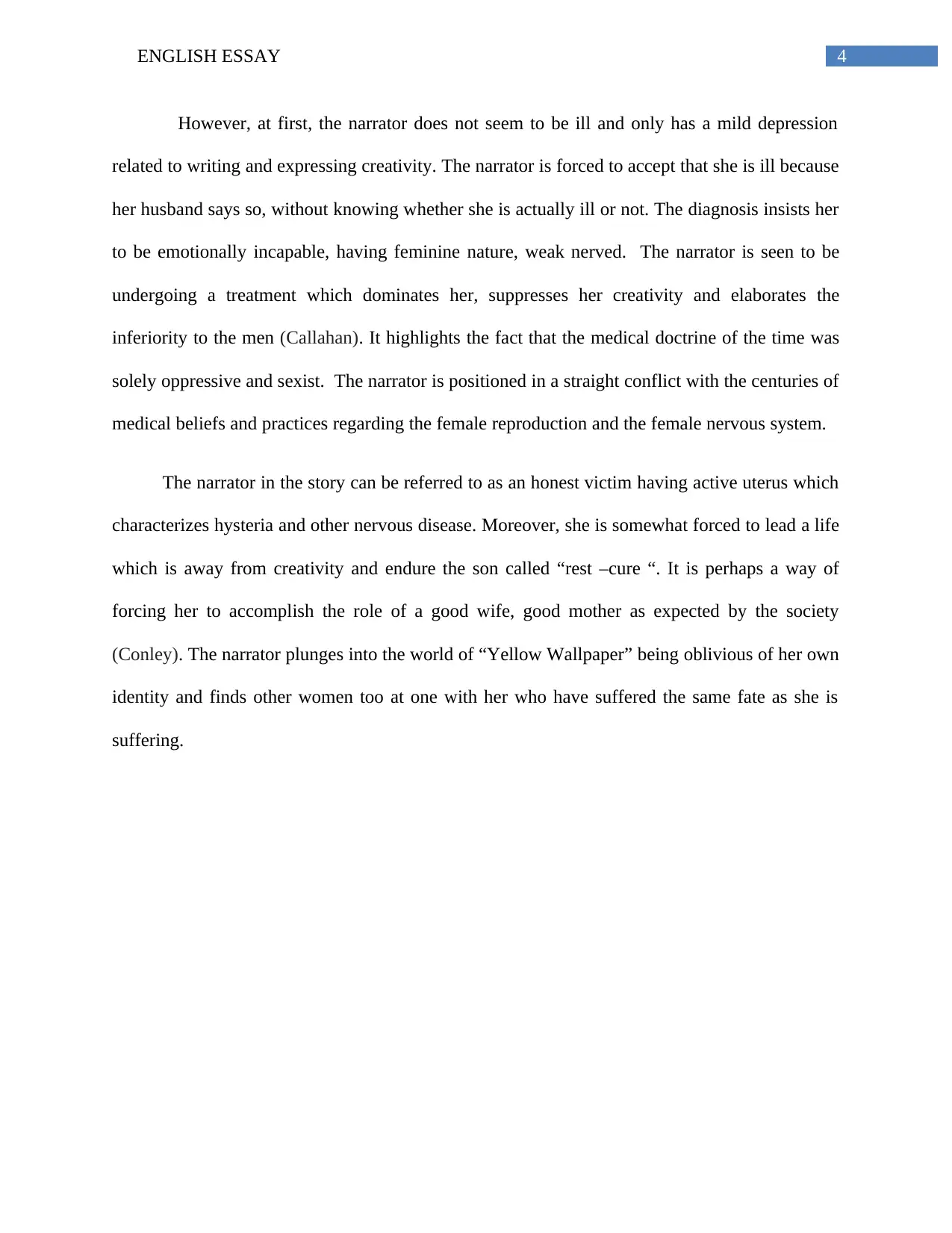
4ENGLISH ESSAY
However, at first, the narrator does not seem to be ill and only has a mild depression
related to writing and expressing creativity. The narrator is forced to accept that she is ill because
her husband says so, without knowing whether she is actually ill or not. The diagnosis insists her
to be emotionally incapable, having feminine nature, weak nerved. The narrator is seen to be
undergoing a treatment which dominates her, suppresses her creativity and elaborates the
inferiority to the men (Callahan). It highlights the fact that the medical doctrine of the time was
solely oppressive and sexist. The narrator is positioned in a straight conflict with the centuries of
medical beliefs and practices regarding the female reproduction and the female nervous system.
The narrator in the story can be referred to as an honest victim having active uterus which
characterizes hysteria and other nervous disease. Moreover, she is somewhat forced to lead a life
which is away from creativity and endure the son called “rest –cure “. It is perhaps a way of
forcing her to accomplish the role of a good wife, good mother as expected by the society
(Conley). The narrator plunges into the world of “Yellow Wallpaper” being oblivious of her own
identity and finds other women too at one with her who have suffered the same fate as she is
suffering.
However, at first, the narrator does not seem to be ill and only has a mild depression
related to writing and expressing creativity. The narrator is forced to accept that she is ill because
her husband says so, without knowing whether she is actually ill or not. The diagnosis insists her
to be emotionally incapable, having feminine nature, weak nerved. The narrator is seen to be
undergoing a treatment which dominates her, suppresses her creativity and elaborates the
inferiority to the men (Callahan). It highlights the fact that the medical doctrine of the time was
solely oppressive and sexist. The narrator is positioned in a straight conflict with the centuries of
medical beliefs and practices regarding the female reproduction and the female nervous system.
The narrator in the story can be referred to as an honest victim having active uterus which
characterizes hysteria and other nervous disease. Moreover, she is somewhat forced to lead a life
which is away from creativity and endure the son called “rest –cure “. It is perhaps a way of
forcing her to accomplish the role of a good wife, good mother as expected by the society
(Conley). The narrator plunges into the world of “Yellow Wallpaper” being oblivious of her own
identity and finds other women too at one with her who have suffered the same fate as she is
suffering.
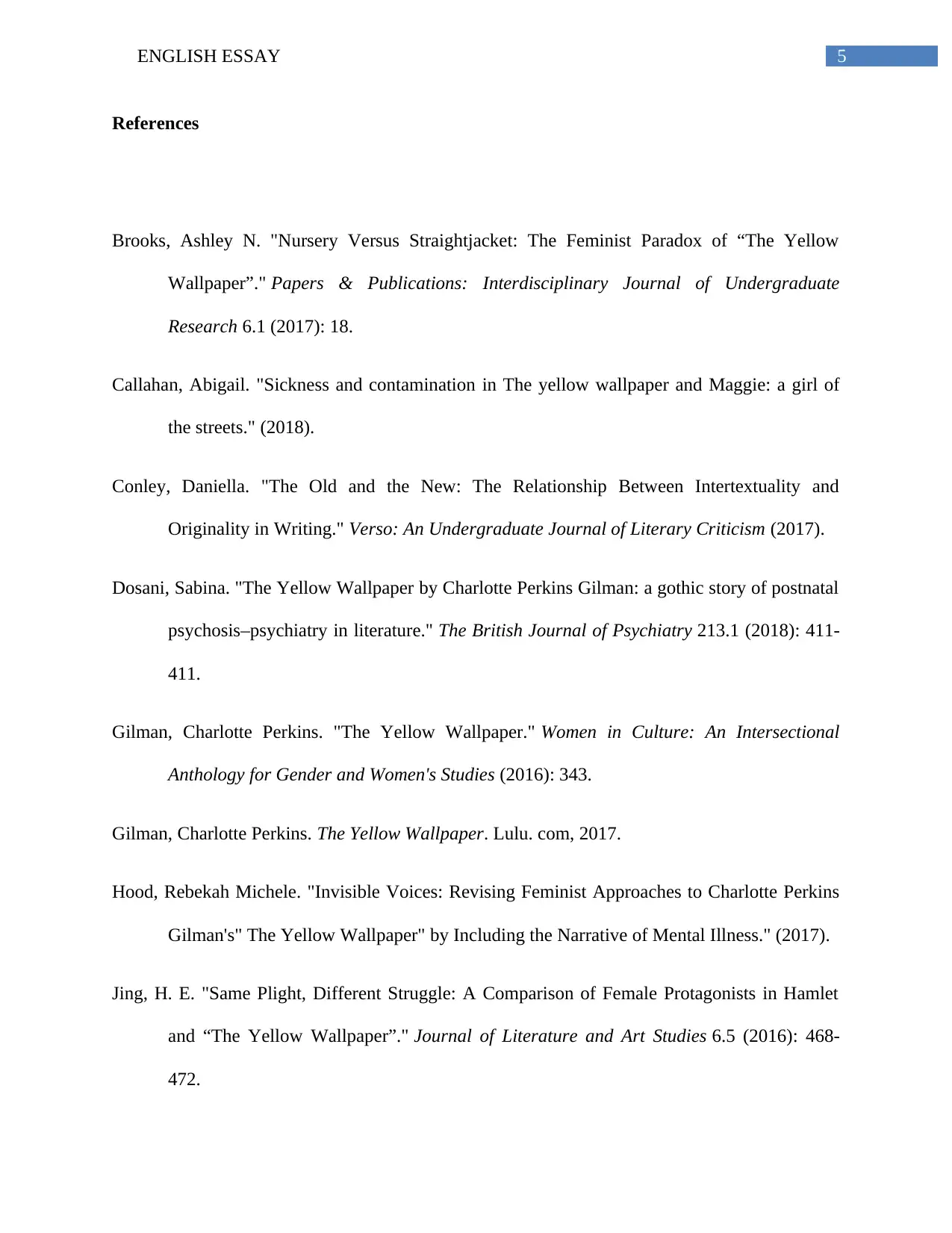
5ENGLISH ESSAY
References
Brooks, Ashley N. "Nursery Versus Straightjacket: The Feminist Paradox of “The Yellow
Wallpaper”." Papers & Publications: Interdisciplinary Journal of Undergraduate
Research 6.1 (2017): 18.
Callahan, Abigail. "Sickness and contamination in The yellow wallpaper and Maggie: a girl of
the streets." (2018).
Conley, Daniella. "The Old and the New: The Relationship Between Intertextuality and
Originality in Writing." Verso: An Undergraduate Journal of Literary Criticism (2017).
Dosani, Sabina. "The Yellow Wallpaper by Charlotte Perkins Gilman: a gothic story of postnatal
psychosis–psychiatry in literature." The British Journal of Psychiatry 213.1 (2018): 411-
411.
Gilman, Charlotte Perkins. "The Yellow Wallpaper." Women in Culture: An Intersectional
Anthology for Gender and Women's Studies (2016): 343.
Gilman, Charlotte Perkins. The Yellow Wallpaper. Lulu. com, 2017.
Hood, Rebekah Michele. "Invisible Voices: Revising Feminist Approaches to Charlotte Perkins
Gilman's" The Yellow Wallpaper" by Including the Narrative of Mental Illness." (2017).
Jing, H. E. "Same Plight, Different Struggle: A Comparison of Female Protagonists in Hamlet
and “The Yellow Wallpaper”." Journal of Literature and Art Studies 6.5 (2016): 468-
472.
References
Brooks, Ashley N. "Nursery Versus Straightjacket: The Feminist Paradox of “The Yellow
Wallpaper”." Papers & Publications: Interdisciplinary Journal of Undergraduate
Research 6.1 (2017): 18.
Callahan, Abigail. "Sickness and contamination in The yellow wallpaper and Maggie: a girl of
the streets." (2018).
Conley, Daniella. "The Old and the New: The Relationship Between Intertextuality and
Originality in Writing." Verso: An Undergraduate Journal of Literary Criticism (2017).
Dosani, Sabina. "The Yellow Wallpaper by Charlotte Perkins Gilman: a gothic story of postnatal
psychosis–psychiatry in literature." The British Journal of Psychiatry 213.1 (2018): 411-
411.
Gilman, Charlotte Perkins. "The Yellow Wallpaper." Women in Culture: An Intersectional
Anthology for Gender and Women's Studies (2016): 343.
Gilman, Charlotte Perkins. The Yellow Wallpaper. Lulu. com, 2017.
Hood, Rebekah Michele. "Invisible Voices: Revising Feminist Approaches to Charlotte Perkins
Gilman's" The Yellow Wallpaper" by Including the Narrative of Mental Illness." (2017).
Jing, H. E. "Same Plight, Different Struggle: A Comparison of Female Protagonists in Hamlet
and “The Yellow Wallpaper”." Journal of Literature and Art Studies 6.5 (2016): 468-
472.
⊘ This is a preview!⊘
Do you want full access?
Subscribe today to unlock all pages.

Trusted by 1+ million students worldwide

6ENGLISH ESSAY
Stuehser, Amber, and Brother Derek Jensen. "Monsters Without and Monsters Within: A Study
of Creativity in The Lives of Mary Wollstonecraft Shelley & Charlotte Perkins Gilman."
(2018).
Stuehser, Amber, and Brother Derek Jensen. "Monsters Without and Monsters Within: A Study
of Creativity in The Lives of Mary Wollstonecraft Shelley & Charlotte Perkins Gilman."
(2018).
1 out of 7
Related Documents
Your All-in-One AI-Powered Toolkit for Academic Success.
+13062052269
info@desklib.com
Available 24*7 on WhatsApp / Email
![[object Object]](/_next/static/media/star-bottom.7253800d.svg)
Unlock your academic potential
Copyright © 2020–2025 A2Z Services. All Rights Reserved. Developed and managed by ZUCOL.





